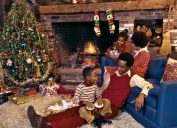Why Do We Hang Ornaments on Christmas Trees? Here's the History
From the Garden of Eden to an American retail tycoon, this is the history of hanging ornaments.

For those who celebrate Christmas, decorating the tree tends to be one of the most festive and fun traditions that loved ones share during the holiday season. There is something about stringing the lights, tossing the tinsel, and hanging all the ornaments you've collected over the years that really fills you with holiday spirit. But, have you ever wondered what led us to this treasured tradition we enjoy every year, including why specifically we hang ornaments on Christmas trees? Well, wonder no longer—here's how it all get started.
The practice of putting up Christmas trees dates all the way back to Germany in the 16th century, History.com points out. During this time, those who observed Christmas began adorning what were called paradise trees with apples, a representation of the tree of knowledge and the forbidden fruit in the Garden of Eden. Then, in the early 17th century, the Germans began the custom of putting up fir trees decorated with, among other things, colorful paper roses, according to The New York Times. And the first accounts of lighted candles being used as Christmas tree decorations are from France in the 18th century, notes the National Christmas Tree Association.
While those apples, roses, and candles were early iterations of what we would become the Christmas ornaments we hang today, it wasn't until 1847 that man-made Christmas ornaments really took off, as Sarah Archer notes in her 2016 book Midcentury Christmas. Shaped like fruit, again as an homage to the tradition's biblical origins, the first glass Christmas ornaments were created by Hans Greiner—a descendent of one of Germany's first glass craftsmen—in Lauscha, Germany. These baubles, as they were called, quickly gained popularity throughout Europe.
Soon, they made their way to England and into Windsor Castle. A 1848 image published in the Illustrated London News and titled "Christmas Tree at Windsor Castle" depicts Queen Victoria, Prince Albert, and other members of the royal family gathered around a Christmas tree decorated with candles and ornaments. "Queen Victoria's mother was German," Kathryn Jones, an assistant curator of decorative arts at the Royal Collection, told BBC News in 2010. "Queen Victoria and Prince Albert brought the tree into Windsor Castle on Christmas Eve, and they would decorate it themselves."
In 1880, a traveling salesmen by the name of Bernard Wilmsen found himself in Lancaster, Pennsylvania, at American retail titan F.W. Woolworth's store. He tried to sell the German glass ornaments to the skeptical businessman. Although Woolworth believed that Americans wouldn't waste their money on such decorations, he reluctantly bought a single case of 144 baubles from Wilmsen. Much to his surprise, he sold them all in mere hours, according to the Woolworth Museum.
The following year, Woolworth's ordered twice the amount of ornaments, and those sold out just as quickly. By that point, the savvy retail tycoon knew he had a winner on his hands. And the rest, as they say, is history—a very lucrative history. Archer estimates Woolworth's stores were selling $25 million in baubles each year by the middle of the 1890s.
Ornaments continue to be a huge money maker to this day. The National Retail Federation reports that Americans spent an estimated $720 billion on Christmas decorations in 2018. We imagine Woolworth would be proud.





















